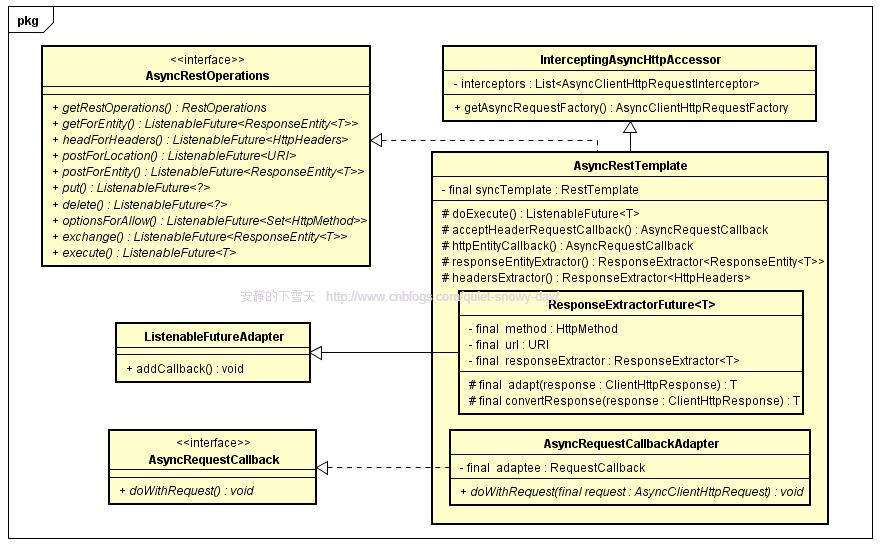【Spring-web】AsyncRestTemplate源码学习
2017-01-23 by 安静的下雪天 http://www.cnblogs.com/quiet-snowy-day/p/6343347.html
本篇概要
类说明
类图
类图中省略了一些参数类型及重载的方法,在不影响理解的情况下,保证各要素在一幅图中展现。

简单例子
private String result = "";
@Test
public void testAsyncPost() throws Exception {
String posturl = "http://xxxxxx";
String params = "xxxxxx";
MultiValueMap<String, String> headers = new LinkedMultiValueMap<String, String>();
headers.add("Content-Type", "application/x-www-form-urlencoded; charset=UTF-8");
HttpEntity<Object> hpEntity = new HttpEntity<Object>(params, headers);
AsyncRestTemplate asyncRt = new AsyncRestTemplate();
ListenableFuture<ResponseEntity<String>> future = asyncRt.postForEntity(posturl, hpEntity, String.class);
future.addCallback(new ListenableFutureCallback<ResponseEntity<String>>() {
public void onSuccess(ResponseEntity<String> resp) {
result = resp.getBody();
}
public void onFailure(Throwable t) {
System.out.println(t.getMessage());
}
});
System.out.println(result);
}
精辟的内部类
/**
* Adapts a {@link RequestCallback} to the {@link AsyncRequestCallback} interface.
*/
private static class AsyncRequestCallbackAdapter implements AsyncRequestCallback { private final RequestCallback adaptee; /**
* Create a new {@code AsyncRequestCallbackAdapter} from the given
* {@link RequestCallback}.
* @param requestCallback the callback to base this adapter on
*/
public AsyncRequestCallbackAdapter(RequestCallback requestCallback) {
this.adaptee = requestCallback;
} @Override
public void doWithRequest(final AsyncClientHttpRequest request) throws IOException {
if (this.adaptee != null) {
this.adaptee.doWithRequest(new ClientHttpRequest() {
@Override
public ClientHttpResponse execute() throws IOException {
throw new UnsupportedOperationException("execute not supported");
}
@Override
public OutputStream getBody() throws IOException {
return request.getBody();
}
@Override
public HttpMethod getMethod() {
return request.getMethod();
}
@Override
public URI getURI() {
return request.getURI();
}
@Override
public HttpHeaders getHeaders() {
return request.getHeaders();
}
});
}
}
}
AsyncRequestCallbackAdapter源码
那么,这里是如何将两个类连接起来的呢?答案关键在于匿名类的使用。
@Override
public void doWithRequest(final AsyncClientHttpRequest request) throws IOException {
if (this.adaptee != null) {
this.adaptee.doWithRequest(new ClientHttpRequestImpl(request));
}
}
private class ClientHttpRequestImpl implements ClientHttpRequest{ private AsyncClientHttpRequest request; public ClientHttpRequestImpl(AsyncClientHttpRequest request){
this.request = request;
}
@Override
public ClientHttpResponse execute() throws IOException {
throw new UnsupportedOperationException("execute not supported");
}
@Override
public HttpMethod getMethod() {
return request.getMethod();
}
@Override
public URI getURI() {
return request.getURI();
}
@Override
public HttpHeaders getHeaders() {
return request.getHeaders();
}
@Override
public OutputStream getBody() throws IOException {
return request.getBody();
}
}
【Spring-web】AsyncRestTemplate源码学习的更多相关文章
- spring源码学习(三)--spring循环引用源码学习
在spring中,是支持单实例bean的循环引用(循环依赖)的,循环依赖,简单而言,就是A类中注入了B类,B类中注入了A类,首先贴出我的代码示例 @Component public class Add ...
- 捋一捋Spring Web的源码思路
Servlet前提 Java规定了Servlet Container为每一个web app创建一个Servlet Context:而Servlet Context中又包含了诸多Servlet -- 其 ...
- 【目录】Spring 源码学习
[目录]Spring 源码学习 jwfy 关注 2018.01.31 19:57* 字数 896 阅读 152评论 0喜欢 9 用来记录自己学习spring源码的一些心得和体会以及相关功能的实现原理, ...
- spring源码学习——spring整体架构和设计理念
Spring是在Rod Johnson的<Expert One-On-One J2EE Development and Design >的基础上衍生而来的.主要目的是通过使用基本的java ...
- Spring5.0源码学习系列之Spring AOP简述
前言介绍 附录:Spring源码学习专栏 在前面章节的学习中,我们对Spring框架的IOC实现源码有了一定的了解,接着本文继续学习Springframework一个核心的技术点AOP技术. 在学习S ...
- Spring源码学习笔记12——总结篇,IOC,Bean的生命周期,三大扩展点
Spring源码学习笔记12--总结篇,IOC,Bean的生命周期,三大扩展点 参考了Spring 官网文档 https://docs.spring.io/spring-framework/docs/ ...
- SpringBoot源码学习1——SpringBoot自动装配源码解析+Spring如何处理配置类的
系列文章目录和关于我 一丶什么是SpringBoot自动装配 SpringBoot通过SPI的机制,在我们程序员引入一些starter之后,扫描外部引用 jar 包中的META-INF/spring. ...
- spring源码学习之路---深入AOP(终)
作者:zuoxiaolong8810(左潇龙),转载请注明出处,特别说明:本博文来自博主原博客,为保证新博客中博文的完整性,特复制到此留存,如需转载请注明新博客地址即可. 上一章和各位一起看了一下sp ...
- spring源码学习之路---IOC初探(二)
作者:zuoxiaolong8810(左潇龙),转载请注明出处,特别说明:本博文来自博主原博客,为保证新博客中博文的完整性,特复制到此留存,如需转载请注明新博客地址即可. 上一章当中我没有提及具体的搭 ...
随机推荐
- [转]Axis2创建WebService实例
以下文章来自http://clq9761.iteye.com/blog/976029,作者clq9761 一.Axis2的下载和安装 1.可从http://ws.apache.org/axis2/ 下 ...
- JAV基础语法之---数据类型转换
数制转换": 1.string 转 byte[] String str = "Hello";byte[] srtbyte = str.getBytes(); 2.byte ...
- hibernate---一对一单向外键关联--annotation (重要!!!)
1. 生成wife.java: package com.bjsxt.hibernate; import javax.persistence.Entity; import javax.persisten ...
- Linux系统的/proc目录
1. /proc目录 Linux 内核提供了一种通过 /proc 文件系统,在运行时访问内核内部数据结构.改变内核设置的机 制.proc文件系统是一个伪文件系统,它只存在内存当中,而不占用外存空间.它 ...
- ASP.NET AJAX 创建类
<%@ Page Language="C#" %> <!DOCTYPE html PUBLIC "-//W3C//DTD XHTML 1.0 Trans ...
- 6种炫酷的CSS3按钮边框动画特效
6种炫酷的CSS3按钮边框动画特效Button border animate 用鼠标滑过下面的按钮看看效果! Draw Draw Meet Center Spin Spin Circle Spin T ...
- CodeForces 625A Guest From the Past
贪心水题 #include <stdio.h> #include <algorithm> #include <string.h> #include <queu ...
- 关于ios 推送功能的终极解决
刚刚做了一个使用推送功能的应用 遇到了一些问题整的很郁闷 搞了两天总算是弄明白了 特此分享给大家 本帖 主要是针对产品发布版本的一些问题 综合了网上一些资料根据自己实践写的 不过测试也可以看看 首先要 ...
- UIAlertView使用全解
举例: UIAlertView *alertView = [[UIAlertView alloc] initWithTitle:@"Default Alert View"messa ...
- Linux cronolog
1. 关于本文 本文将以cronolog 1.6.2.apache 2.2.6为例,以CentOS 5为平台,讲述cronolog的安装和设置. 2. 关于cronolog cronol ...
